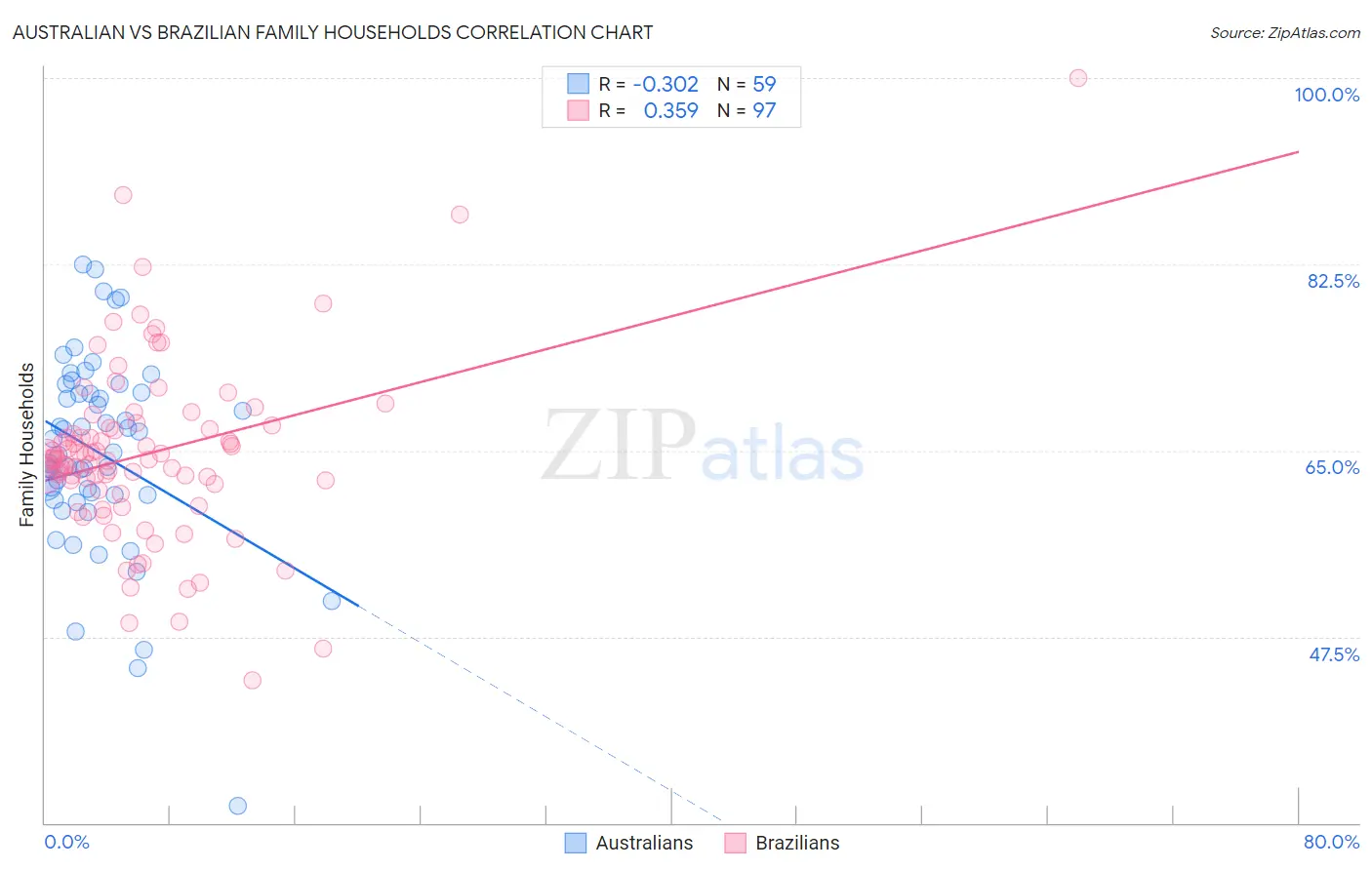Australian vs Brazilian Family Households
COMPARE
Australian
Brazilian
Family Households
Family Households Comparison
Australians
Brazilians
62.8%
FAMILY HOUSEHOLDS
0.1/ 100
METRIC RATING
284th/ 347
METRIC RANK
63.9%
FAMILY HOUSEHOLDS
12.4/ 100
METRIC RATING
205th/ 347
METRIC RANK
Australian vs Brazilian Family Households Correlation Chart
The statistical analysis conducted on geographies consisting of 224,034,220 people shows a mild negative correlation between the proportion of Australians and percentage of family households in the United States with a correlation coefficient (R) of -0.302 and weighted average of 62.8%. Similarly, the statistical analysis conducted on geographies consisting of 323,732,843 people shows a mild positive correlation between the proportion of Brazilians and percentage of family households in the United States with a correlation coefficient (R) of 0.359 and weighted average of 63.9%, a difference of 1.6%.

Family Households Correlation Summary
| Measurement | Australian | Brazilian |
| Minimum | 31.6% | 43.4% |
| Maximum | 82.4% | 100.0% |
| Range | 50.9% | 56.6% |
| Mean | 64.8% | 64.7% |
| Median | 64.9% | 64.2% |
| Interquartile 25% (IQ1) | 60.9% | 61.5% |
| Interquartile 75% (IQ3) | 70.5% | 67.3% |
| Interquartile Range (IQR) | 9.6% | 5.8% |
| Standard Deviation (Sample) | 9.3% | 8.5% |
| Standard Deviation (Population) | 9.2% | 8.4% |
Similar Demographics by Family Households
Demographics Similar to Australians by Family Households
In terms of family households, the demographic groups most similar to Australians are Immigrants from Denmark (62.9%, a difference of 0.040%), New Zealander (62.9%, a difference of 0.050%), Estonian (62.9%, a difference of 0.080%), Mongolian (62.8%, a difference of 0.10%), and British West Indian (62.8%, a difference of 0.13%).
| Demographics | Rating | Rank | Family Households |
| Ottawa | 0.3 /100 | #277 | Tragic 63.0% |
| Immigrants | Belgium | 0.2 /100 | #278 | Tragic 63.0% |
| Immigrants | Yemen | 0.2 /100 | #279 | Tragic 63.0% |
| Immigrants | Bulgaria | 0.2 /100 | #280 | Tragic 63.0% |
| Estonians | 0.2 /100 | #281 | Tragic 62.9% |
| New Zealanders | 0.1 /100 | #282 | Tragic 62.9% |
| Immigrants | Denmark | 0.1 /100 | #283 | Tragic 62.9% |
| Australians | 0.1 /100 | #284 | Tragic 62.8% |
| Mongolians | 0.1 /100 | #285 | Tragic 62.8% |
| British West Indians | 0.1 /100 | #286 | Tragic 62.8% |
| Latvians | 0.1 /100 | #287 | Tragic 62.8% |
| Immigrants | Uganda | 0.1 /100 | #288 | Tragic 62.7% |
| Immigrants | Nepal | 0.1 /100 | #289 | Tragic 62.7% |
| Immigrants | Grenada | 0.0 /100 | #290 | Tragic 62.6% |
| U.S. Virgin Islanders | 0.0 /100 | #291 | Tragic 62.6% |
Demographics Similar to Brazilians by Family Households
In terms of family households, the demographic groups most similar to Brazilians are Immigrants from Uruguay (63.9%, a difference of 0.010%), Immigrants from Lithuania (63.9%, a difference of 0.010%), Iranian (63.9%, a difference of 0.030%), Norwegian (63.9%, a difference of 0.030%), and Nigerian (63.9%, a difference of 0.030%).
| Demographics | Rating | Rank | Family Households |
| Poles | 18.9 /100 | #198 | Poor 64.0% |
| Slavs | 18.6 /100 | #199 | Poor 64.0% |
| Immigrants | Malaysia | 17.9 /100 | #200 | Poor 64.0% |
| Immigrants | Eastern Europe | 17.2 /100 | #201 | Poor 64.0% |
| Iranians | 13.5 /100 | #202 | Poor 63.9% |
| Norwegians | 13.2 /100 | #203 | Poor 63.9% |
| Immigrants | Uruguay | 12.8 /100 | #204 | Poor 63.9% |
| Brazilians | 12.4 /100 | #205 | Poor 63.9% |
| Immigrants | Lithuania | 12.1 /100 | #206 | Poor 63.9% |
| Nigerians | 11.5 /100 | #207 | Poor 63.9% |
| Immigrants | Bangladesh | 11.4 /100 | #208 | Poor 63.9% |
| Sierra Leoneans | 11.2 /100 | #209 | Poor 63.9% |
| Immigrants | Thailand | 9.6 /100 | #210 | Tragic 63.8% |
| Shoshone | 9.4 /100 | #211 | Tragic 63.8% |
| Immigrants | Netherlands | 9.4 /100 | #212 | Tragic 63.8% |